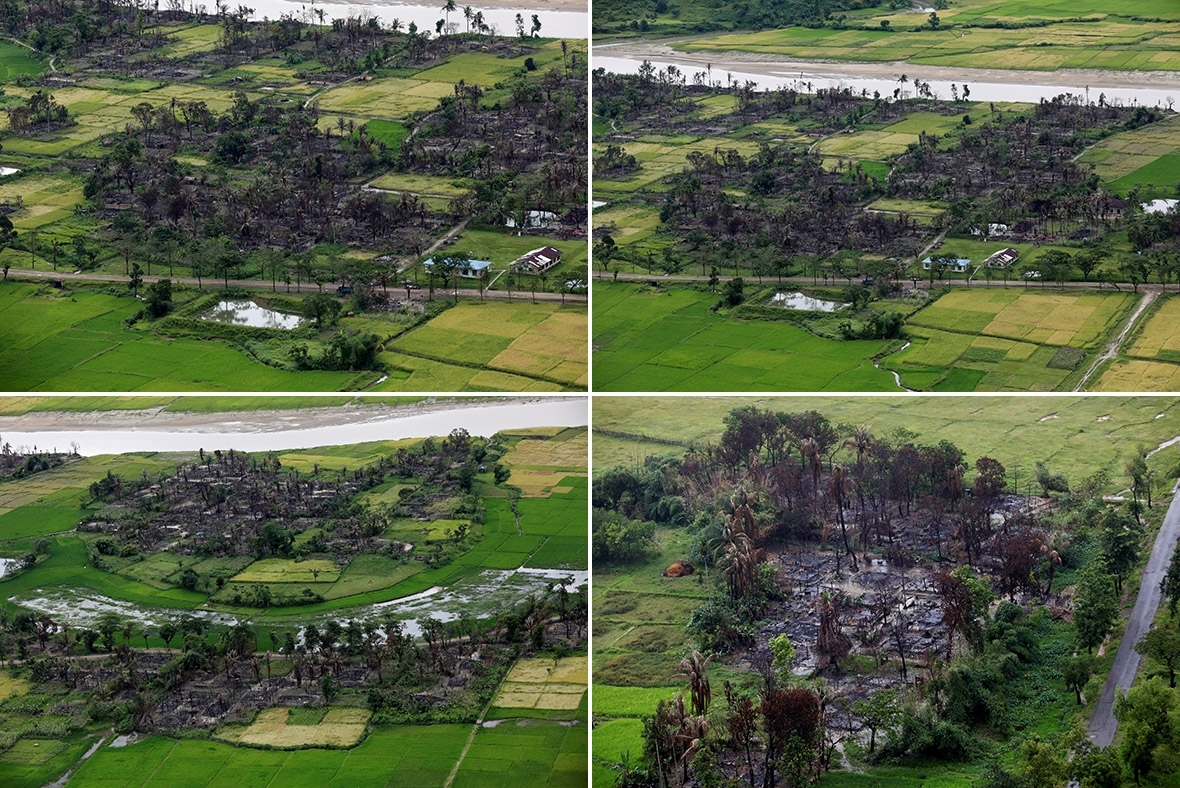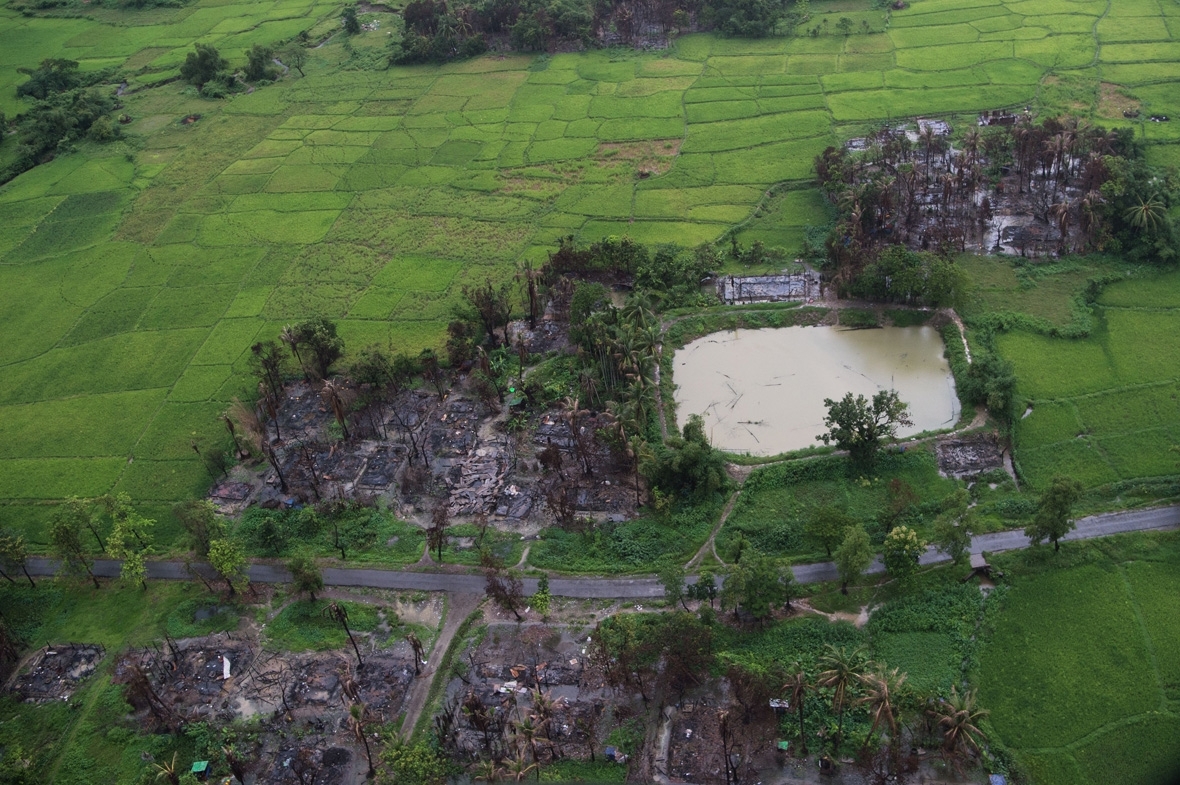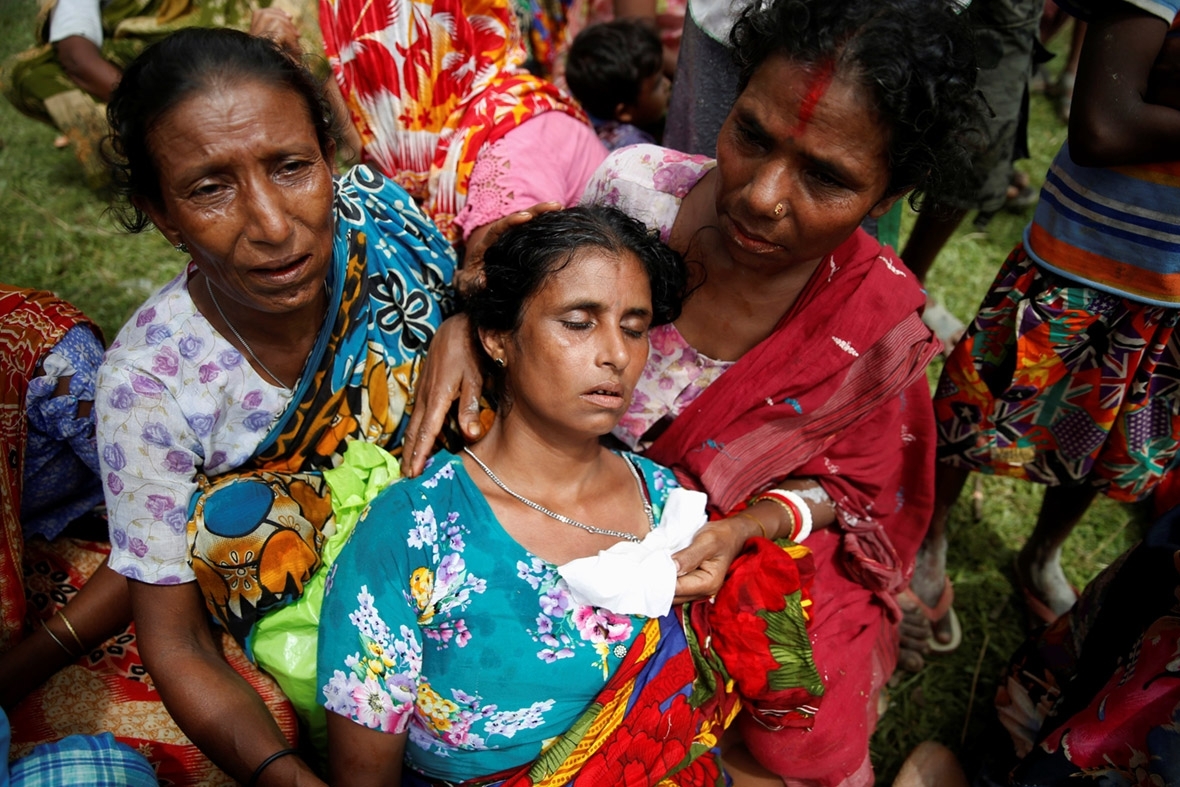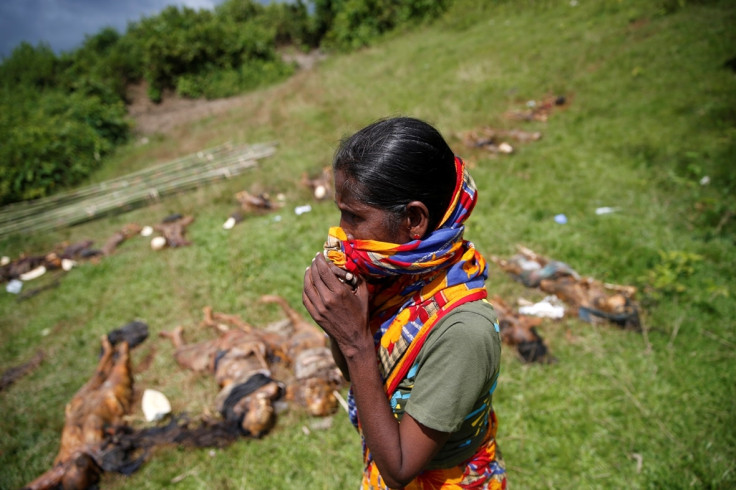First look at burnt Rohingya Muslim villages in Rakhine state, Myanmar
Reporters have finally been allowed to venture into Myanmar's northern Rakhine state, formerly home to hundreds of thousands of Rohingya Muslims who have fled into Bangladesh.
Reporters have finally been allowed to venture into Myanmar's northern Rakhine state, formerly home to hundreds of thousands of Rohingya Muslims who have fled into Bangladesh. The military took a group of journalists by helicopter to Maungdaw to see the bodies of Hindu villagers who authorities say were killed by Muslim insurgents.
Along the way, photojournalists took aerial photos of burned-out Rohingya villages. All but one of the villages along the main road that stretches nearly 40 kilometres north from Maungdaw have been turned into smouldering ash. The remains of local mosques, markets and schools – once bustling with Rohingya Muslims – are silent.
Scroll through this slideshow to see village after village reduced to ash and embers:














Satellite photos show that tens of thousands of homes in northern Rakhine have been destroyed in 214 villages, New York-based Human Rights Watch (HRW) said. The UN detected 20 square kilometres (eight square miles) of destroyed structures.
The Myanmar government blames the Rohingya villagers and the Arakan Rohingya Salvation Army (ARSA), which staged the attacks on 25 August that led to the mass crackdown. "The information we obtained on this side is that terrorists did the burnings," said Zaw Htay, spokesman for Aung San Suu Kyi.


Little aid has made it to northern Rakhine since the UN had to suspend operations because of the fighting and after the government suggested its food was sustaining insurgents. Convoys organised by the Red Cross have twice been stopped and searched by hostile ethnic Rakhines in the state capital Sittwe.
In U Shey Kya, a teacher who spoke to Reuters from the village by phone said only about 100 families out of 800 households have stayed behind. Those who remain are playing a cat-and-mouse game with the soldiers, who come to the village in the morning prompting the residents to hide in the forest and return at night.
"We don't even have food to eat for this evening. What can we do?" said the teacher. "We are close to the forest where we have leaves we can eat and find some water to survive." He refused to give his name because he had been warned by the authorities not to talk to reporters. The man said escaping through bush in monsoon rain with his elderly parents, six children and pregnant wife was not an option.
Rohingya who have fled to Bangladesh and human rights organisations say ethnic Rakhine vigilantes have aided the military in driving out the Muslim population. Kamal Hussein, 22, from Alel Than Kyaw, south of Maungdaw town, said his village was destroyed in early September, after which he fled to Bangladesh, where he spoke to Reuters.
Hussein said Rakhine mobs "poured petrol on the houses. Then, they came out and the military fired a grenade launcher at a house to set it alight". Government spokesman Zaw Htay said some empty buildings in the area had been burned by ethnic Rakhines. "We told the regional government to take action on that," he said.
The news that authorities found the bodies of 45 Hindu villagers in mass graves in the north of Rakhine state has dominated Myanmar's media coverage of a new round of violence in old strife between the state's Buddhists and Muslims.
The military flew reporters from the city of Yangon to see the bodies laid out on the grass, and to hear from those who found them after information about the massacre filtered back from Hindus who have sought refuge from the violence in Bangladesh.


The latest violence in Rakhine state erupted on 25 August, when Rohingya Muslim insurgents attacked 30 police posts and an army camp, killing about 12 people. Hours later, insurgents of the Arakan Rohingya Salvation Army (ARSA) came to the Hindu village of Ye Baw Kya, gathered up about 100 people, marched them away through their fields and killed them with knives, the government says.
The military response to the insurgent attacks has driven 480,000 Rohingya refugees to Bangladesh and drawn UN accusations of ethnic cleansing by the army with the help of Buddhist vigilantes. Myanmar denies that, saying its forces are fighting ruthless terrorists. For the government, the proof of the insurgents' brutality is plain to see, lying in rows by the mass graves just outside the village of Ye Baw Kya. "This is terrorism," Minister for Social Welfare, Relief and Resettlement, Win Myat Aye, who visited the site, told Reuters.
ARSA has denied killing the Hindus, saying they never kill civilians.

Exactly why Myanmar's tiny Hindu minority in Rakhine state got caught up in the bloodshed is not clear, and different people have given different accounts at different times. Some villagers have said the insurgents suspected Hindus of being on the side of the government and acting as government spies.
In late August, Reuters reporters in Bangladesh interviewed a group of Hindu women from the village who said their male loved ones were killed by Rakhine Buddhists. However, three of the same women told Reuters this week that Muslims who brought them to Bangladesh had ordered them to say it was Buddhist vigilantes who had done the killing.
The same #Hindu women gave two versions of testimonies. First they said their husbands were killed by #Rakhine Buddhists. Now saying #Muslims. https://t.co/P8L21o7w1S @mdskar pic.twitter.com/EDwjszVhRE
— Ro Nay San Lwin (@nslwin) September 28, 2017
The three – who individually recounted closely matching stories – said that on 25 August, they and about 100 other Hindus were marched by masked men to the area of the mass graves. They were later able to identify some of the masked men as Rohingya Muslims, although the women said the men spoke several languages they could not identify, besides the dialect spoken by both Muslims and Hindus in the area.
"We watched as they tied each person, hands behind their back and also legs ... They cut all their throats and pushed them into a hole," said one of the women, Bina Bala, 22, adding that the women were spared after promising to convert to Islam. They said the attackers had objected to official identity cards given to Hindus but not Muslims, saying Hindus should not have them.
The victims were blindfolded, with their hands tied and had their throats slit, said Kyaw Maung Maung Thien, hospital superintendent in the Myanmar town of Maungdaw, who examined the bodies. "The evidence points to a massacre by the ARSA terrorists," he told the state-run Global New Light of Myanmar newspaper.
While the accusations fly, the bodies await cremation. Police have been guarding the site of the mass graves, lighting fires at night to keep wild dogs away.
Maungdaw town itself, until recently ethnically mixed with Rakhine Buddhists, Muslims and some Hindus, is now segregated, with the remaining Rohingya shuttered in their homes. "Those who stored food, sold it and raised money to flee to Bangladesh," Mohammad Salem, 35, who used to sell cosmetics at the market, told Reuters by phone from the town.




Tin Tun Soe, a Rakhine administrator in Chein Khar Li, where a security post had come under attack, said the army response was rapid and all the Rohingya had been driven out. Nearly 1,600 houses were burned down a day after the attacks, he said, though he blamed the fires on the insurgents. "They have so many people. If they are here, we're afraid to live," said Tin Tun Soe. "I am very happy that now all of them are gone."
How you can help the Rohingya refugees: Donate To Unicef UK , Oxfam, Action against Hunger, Amnesty International or UNHCR
© Copyright IBTimes 2025. All rights reserved.






















